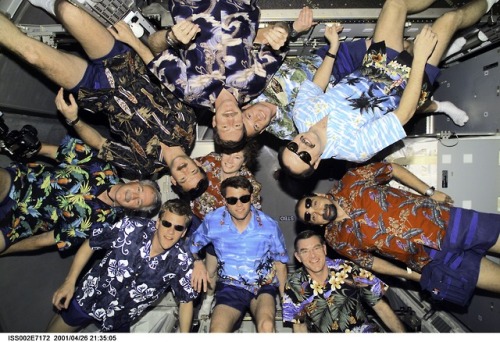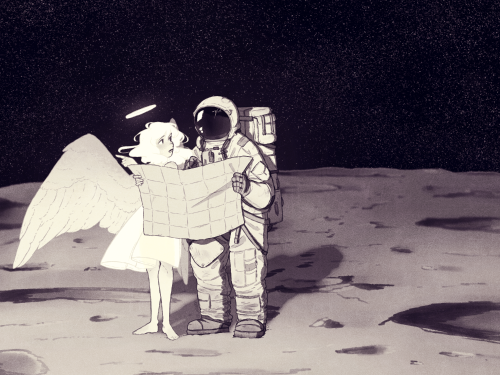3 … 2 … 1… ALOHA!

3 … 2 … 1… ALOHA!
Sometimes in space, you have to set your clocks to island time and gather for a good Hawaiian shirt day. In this 2001 #TBT, Expedition Two and STS-100 crew members gather for a group photo with a pre-set digital still camera.
Clockwise from the 12 o'clock point in the circle are Kent V. Rominger, Yuri V. Lonchakov, Yury V. Usachev, Umberto Guidoni, James S. Voss, Jeffrey S. Ashby, Scott E. Parazynski, John L. Phillips and Chris A. Hadfield, with Susan J. Helms at center. Usachev, Helms and Voss are members of three Expedition Two crew, with the other seven serving as the STS-100 crew on the Space Shuttle Endeavour. Usachev and Lonchakov represent Rosaviakosmos; Guidoni is associated with the European Space Agency (ESA); and Hadfield is from the Canadian Space Agency (CSA).
Make sure to follow us on Tumblr for your regular dose of space: http://nasa.tumblr.com.
More Posts from Space-cute and Others
![Milky Way Over Walupt Lake, WA [5184x3456] [OC] By Robbeninson](https://64.media.tumblr.com/f85502da93464e1d50121925dc8a68d9/tumblr_pdw2k7L4zV1wf4hhqo1_500.jpg)
Milky Way over Walupt Lake, WA [5184x3456] [OC] by robbeninson
★☆★ SPACE ★☆★

Stars over water reservoir in austria by H4ppy4uer89
★☆★ SPACE ★☆★
Astronaut tweets
























Hale-Bopp: The Great Comet of 1997 : Only twenty-five years ago, Comet Hale-Bopp rounded the Sun and offered a dazzling spectacle in planet Earth’s night skies. Digitized from the original astrophoto on 35mm color slide film, this classic image of the Great Comet of 1997 was recorded a few days after its perihelion passage on April 1, 1997. Made with a camera and telephoto lens piggy-backed on a small telescope, the 10 minute long, hand-guided exposure features the memorable tails of Hale-Bopp, a whitish dust tail and blue ion tail. Here, the ion tail extends well over ten degrees across the northern sky. In all, Hale-Bopp was reported as visible to the naked eye from late May 1996 through September 1997. Also known as C/1995 O1, Hale-Bopp is recognized as one of the most compositionally pristine comets to pass through the inner Solar System. A visitor from the distant Oort cloud, the comet’s next perihelion passage should be around the year 4380 AD. Do you remember Hale-Bopp? via NASA

This is another photo of the Jupiter Saturn Conjunction! 🪐🪐🪐
The two planets are getting closer each day! I love this picture because you can clearly see Jupiter’s 4 largest moons (Io, Europa, Ganymede, and Callisto) and a nice view of Saturn. This event is very rare - Jupiter and Saturn are the closest since the year 1623! ✨✨✨
Taken by me (Michelle Park) using the Slooh Canary Two telescope on December 20th, 2020 at 19:24 UTC.

Cosmonaut Ivan Vagner obtained this image of the comet NEOWISE a few hours ago from the International Space Station. He says that the dust tail looks very good from there. It is worth enlarging the image.
via reddit

Asking for directions

hey, @bunjywunjy - this might be your jam (and any other dinosaur enthusiasts, it’s a heck of a read)

El Gordo Galaxy Cluster
-
 gallifreyandistress liked this · 3 years ago
gallifreyandistress liked this · 3 years ago -
 justatheatrekidwholovesspace liked this · 4 years ago
justatheatrekidwholovesspace liked this · 4 years ago -
 aaaaaaaaaaaavm liked this · 4 years ago
aaaaaaaaaaaavm liked this · 4 years ago -
 ironside451 reblogged this · 4 years ago
ironside451 reblogged this · 4 years ago -
 ironside451 liked this · 4 years ago
ironside451 liked this · 4 years ago -
 gaetanopezzella liked this · 4 years ago
gaetanopezzella liked this · 4 years ago -
 ooooooooooooooops liked this · 5 years ago
ooooooooooooooops liked this · 5 years ago -
 junohnebula liked this · 5 years ago
junohnebula liked this · 5 years ago -
 briefbearjudgegoth liked this · 5 years ago
briefbearjudgegoth liked this · 5 years ago -
 sayulitashirtcompany reblogged this · 5 years ago
sayulitashirtcompany reblogged this · 5 years ago -
 majalasota liked this · 5 years ago
majalasota liked this · 5 years ago -
 shandira liked this · 5 years ago
shandira liked this · 5 years ago -
 casualwonderlandtale liked this · 5 years ago
casualwonderlandtale liked this · 5 years ago -
 that-demon-named-dustin liked this · 5 years ago
that-demon-named-dustin liked this · 5 years ago -
 good-gay-vibes-blog liked this · 5 years ago
good-gay-vibes-blog liked this · 5 years ago -
 automaticdestinytrash reblogged this · 5 years ago
automaticdestinytrash reblogged this · 5 years ago -
 mshilling1821 reblogged this · 5 years ago
mshilling1821 reblogged this · 5 years ago -
 mshilling1821 liked this · 5 years ago
mshilling1821 liked this · 5 years ago -
 changeursmile-20192811 liked this · 5 years ago
changeursmile-20192811 liked this · 5 years ago -
 mrrigel liked this · 5 years ago
mrrigel liked this · 5 years ago -
 snickerzer liked this · 5 years ago
snickerzer liked this · 5 years ago -
 aphthranduil liked this · 5 years ago
aphthranduil liked this · 5 years ago -
 babyhoba liked this · 5 years ago
babyhoba liked this · 5 years ago -
 urlocalmilf liked this · 5 years ago
urlocalmilf liked this · 5 years ago -
 mtn53 liked this · 5 years ago
mtn53 liked this · 5 years ago -
 struwburry liked this · 5 years ago
struwburry liked this · 5 years ago -
 kiruskak-blog liked this · 5 years ago
kiruskak-blog liked this · 5 years ago -
 rot-gospel liked this · 5 years ago
rot-gospel liked this · 5 years ago -
 laviadelmale reblogged this · 5 years ago
laviadelmale reblogged this · 5 years ago
